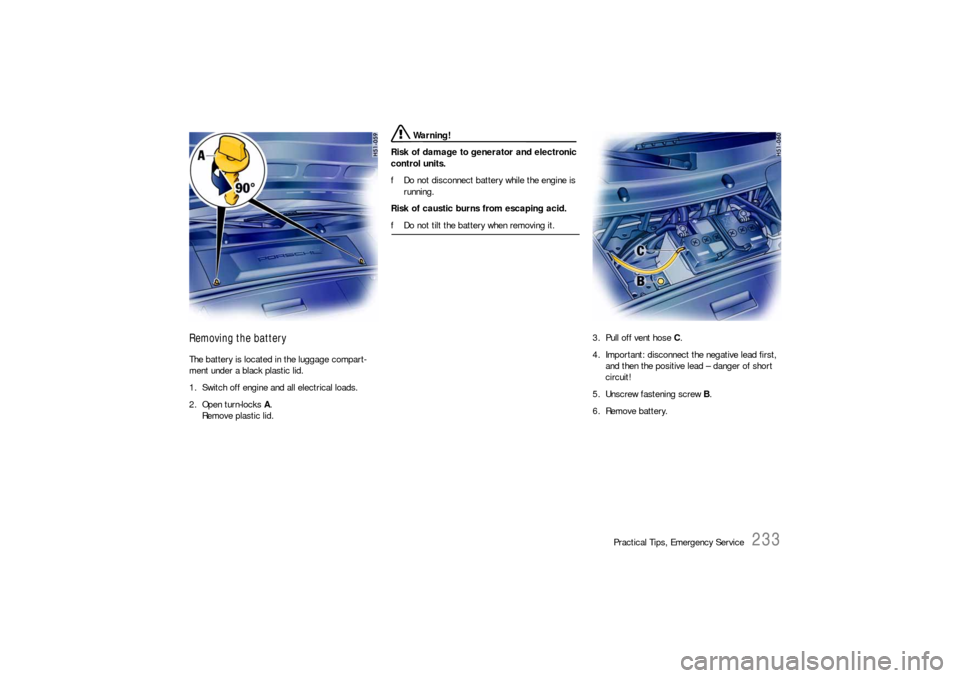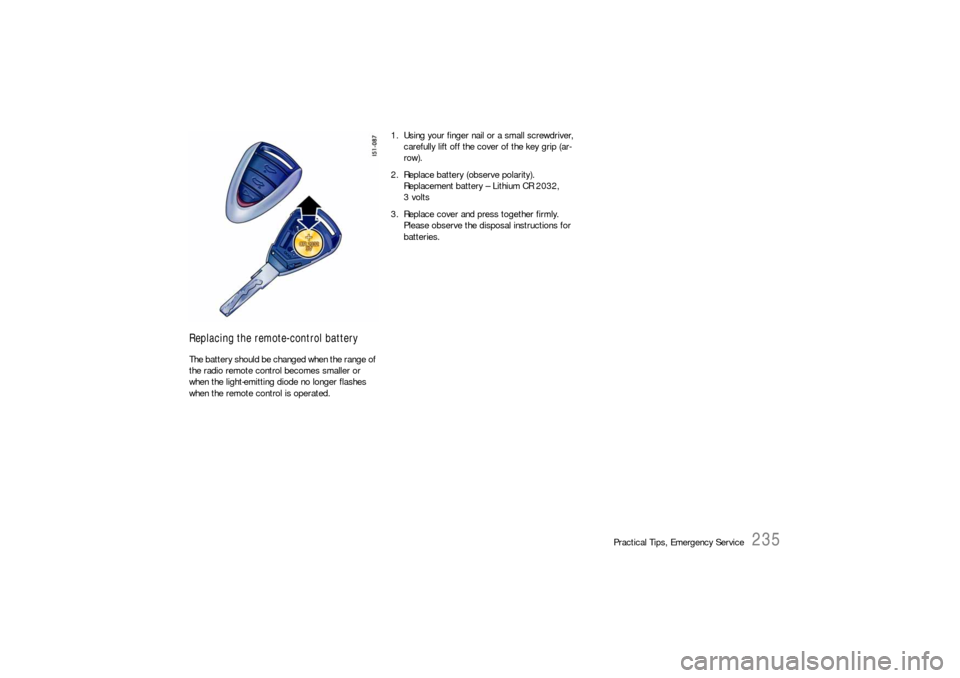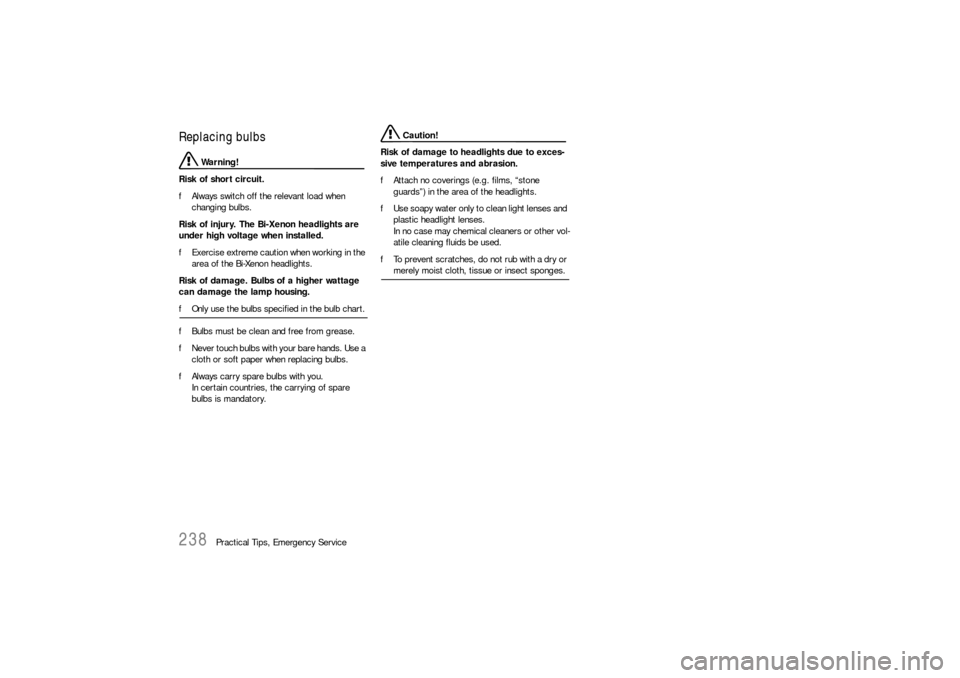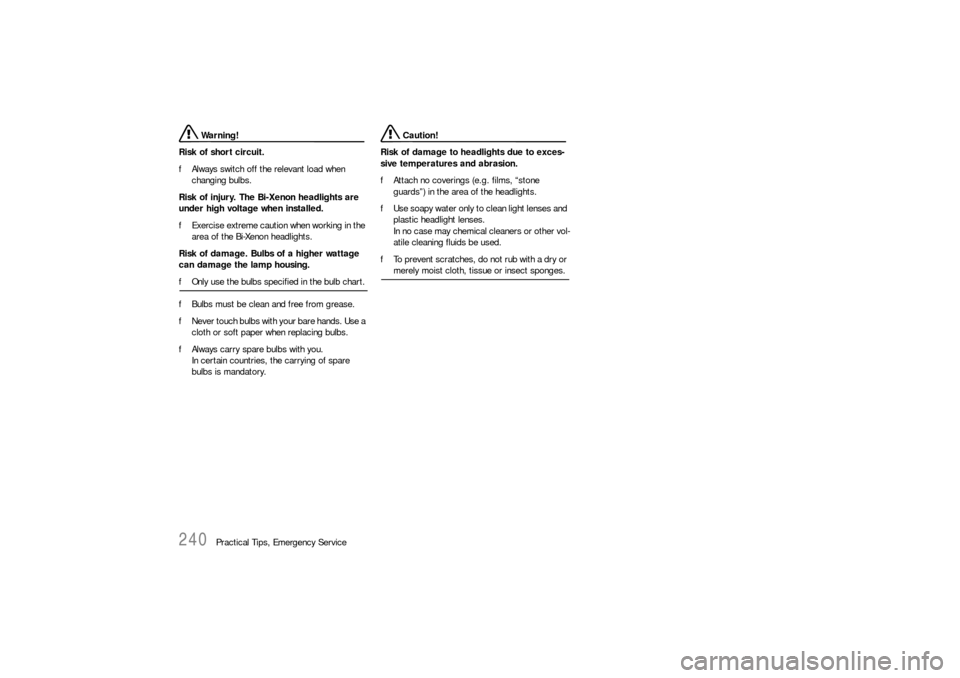PORSCHE BOXSTER 2005 2.G Owners Manual
Manufacturer: PORSCHE, Model Year: 2005, Model line: BOXSTER, Model: PORSCHE BOXSTER 2005 2.GPages: 276, PDF Size: 4.05 MB
Page 231 of 276

Practical Tips, Emergency Service
231
Winter drivingThe capacity and ability of the battery to store
power decreases at low outside temperatures.
Moreover, the battery is more heavily loaded in the
winter months, e.g. by the heated rear window,
the more frequent use of additional lights, the
blower and the windshield wipers, etc.
fHave the battery checked before winter
begins.
Keep the battery well charged to prevent it from
freezing.
A discharged battery can freeze even at
23°F/-5 °
C, but a fully charged one only freezes at
-40°F/-40 °C.
Laying up the vehicleIf the vehicle stands for long periods in the garage
or workshop, the doors and lids should be closed.
fPlease observe the chapter “EMERGENCY
UNLOCKING OF THE FRONT LUGGAGE
COMPARTMENT LID” on Page 228.
fWithdraw the ignition key and, if necessary,
disconnect the battery.
When the battery is disconnected, the
alarm system ceases to function!
Even if you put your vehicle out of operation, the
battery still discharges.
fThe battery must be charged, i.e. connected
to a charger, approximately every 6 weeks in
order to preserve functioning.
Always observe the instructions of the charger
manufacturer.
fStore a battery that has been removed in a
dark, cool place, but not subject to frost.
Replacing the batteryThe battery is subject to normal wear: its service
life depends heavily on the care you give it,
climatic conditions and the conditions of use
(distances, loads).
It is not possible to use the details on the battery
case to determine a comparable battery that
meets all the specific requirements of Porsche.
fUse only a battery that meets the specific
requirements of your vehicle as a replacement.
We recommend that you use an Orignal
Porsche battery.
fPlease observe the disposal instructions for
batteries!
Page 232 of 276

232
Practical Tips, Emergency Service
Putting vehicle into operationAfter the battery is connected or after an exhaus-
tively discharged battery is charged, the multi-
functional PSM light lights up on the instrument
panel and a message appears on the on-board
computer to indicate a fault.
This fault can be remedied with a few simple
steps:
1. Start the engine.
2. With the vehicle stationary, perform a few
steering movements to the left and right and
then drive a short distance in a straight line
until the multifunctinal PSM light goes out and
the message on the on-board computer
disappears.
3. If the warnings do not disappear, then:
Drive carefully to the nearest qualified
specialist workshop.
Have the fault remedied.
4. After the warnings disappear, stop the vehicle
in a suitable place.
5. Perform adaptation of the power windows:
Please observe the chapter “STORING END
POSITION OF THE WINDOWS” on Page 29.Ignition key/ignition lock
fDo not insert the ignition key into the ignition
lock if the vehicle battery is discharged.
The ignition key can no longer be removed.
The key cannot be removed until the vehicle elec-
trical system is supplied with power again.
fPlease observe the chapter “EMERGENCY UN-
LOCKING OF THE FRONT LUGGAGE COMPART-
MENT LID” on Page 228.
6. Please observe the chapter “JUMP LEAD
STARTING” on Page 236.
Page 233 of 276

Practical Tips, Emergency Service
233
Removing the batteryThe battery is located in the luggage compart-
ment under a black plastic lid.
1. Switch off engine and all electrical loads.
2. Open turn-locks A.
Remove plastic lid.
Warning!
Risk of damage to generator and electronic
control units.
fDo not disconnect battery while the engine is
running.
Risk of caustic burns from escaping acid.
fDo not tilt the battery when removing it.
3. Pull off vent hose C.
4. Important: disconnect the negative lead first,
and then the positive lead – danger of short
circuit!
5. Unscrew fastening screw B.
6. Remove battery.
Page 234 of 276

234
Practical Tips, Emergency Service
Installing the battery1. Insert battery and push it all the way to the
stop.
2. Tighten fastening screw B.
3. Important: connect the positive cable first and
then the negative cable – risk of short circuit!
4. Push on vent hose C.
5. Fit plastic lid.
Lock turn-locks A.
Page 235 of 276

Practical Tips, Emergency Service
235
Replacing the remote-control batteryThe battery should be changed when the range of
the radio remote control becomes smaller or
when the light-emitting diode no longer flashes
when the remote control is operated.1. Using your finger nail or a small screwdriver,
carefully lift off the cover of the key grip (ar-
row).
2. Replace battery (observe polarity).
Replacement battery – Lithium CR 2032,
3volts
3. Replace cover and press together firmly.
Please observe the disposal instructions for
batteries.
Page 236 of 276

236
Practical Tips, Emergency Service
Jump lead startingfPlease observe the chapter “EMERGENCY
UNLOCKING OF THE FRONT LUGGAGE
COMPARTMENT LID” on Page 228.
fPlease observe the chapter “BATTERY” on
Page 229.
If the battery is flat, the battery of another vehicle
can be used to start the car with the aid of jump
leads.
Both batteries must be 12 volt types. The
capacity (Ampere hours, Ah) of the donor battery
must not be substantially less than that of the
discharged battery.
The discharged battery must be correctly
connected to the vehicle’s electrical system.
Warning!
Risk of damage and injury due to short
circuit.
fUse only standard jump leads with sufficient
cross section and completely insulated
clamps.
Follow the jump lead manufacturer’s instruc-
tions.
fRoute the jump leads so that they cannot be
caught by moving parts in the engine compart-
ment.
The vehicles must not be in contact, otherwise
current might flow as soon as the positive
terminals are connected.
fCarefully ensure that conductive jewellery
(rings, chains, watch straps) do not come into
contact with live parts of the vehicle.
Danger of caustic burns.
fDo not lean over the battery.
Danger of gas explosion.
fKeep sources of ignition, e.g. naked flame,
burning cigarettes or sparks due to cable
contact, away from the battery.
fBefore connecting jump leads, it is essential to thaw out a frozen battery.
Connecting jump leadsAlways observe the sequence below:
1. Connect the red positive lead to the positive
terminal of the discharged battery first, then
connect it to the positive terminal of the donor
battery.
2. First connect the black negative cable to the
negative terminal of the donor battery, then
connect it to a suitable grounding point on the
vehicle with the discharged battery.
This grounding point must lie as far as possible
from the battery.
For example, a solid metal part or the engine
block are suitable grounding points.
If no suitable grounding points are to be found
on either vehicle, the negative cable must
carefully be connected directly to the negative
terminal of the battery.
If a suitable grounding point is to be found only
on the donor vehicle, the negative cable must
first be connected to the terminal of the
discharged battery, then to the grounding point
of the donor vehicle.
Page 237 of 276

Practical Tips, Emergency Service
237
3. Run the engine of the donor car at a higher
speed.
4. Start the engine.
An attempted start using jump leads should
not last more than 15 seconds. Then allow a
waiting period of at least one minute.
5.Note
Before disconnecting the jump leads, electrical
loads such as the heated rear window and the
heating fan blower should be switched on (the
vehicle’s lights must not be switched on). This
reduces voltage peaks which may occur when
disconnecting the jump leads.
With the engine running, remove both jump
leads in reverse order.
Page 238 of 276

238
Practical Tips, Emergency Service
Replacing bulbs
Warning!
Risk of short circuit.
fAlways switch off the relevant load when
changing bulbs.
Risk of injury. The Bi-Xenon headlights are
under high voltage when installed.
fExercise extreme caution when working in the
area of the Bi-Xenon headlights.
Risk of damage. Bulbs of a higher wattage
can damage the lamp housing.
fOnly use the bulbs specified in the bulb chart.
fBulbs must be clean and free from grease.
fNever touch bulbs with your bare hands. Use a
cloth or soft paper when replacing bulbs.
fAlways carry spare bulbs with you.
In certain countries, the carrying of spare
bulbs is mandatory.
Caution!
Risk of damage to headlights due to exces-
sive temperatures and abrasion.
fAttach no coverings (e.g. films, “stone
guards”) in the area of the headlights.
fUse soapy water only to clean light lenses and
plastic headlight lenses.
In no case may chemical cleaners or other vol-
atile cleaning fluids be used.
fTo prevent scratches, do not rub with a dry or merely moist cloth, tissue or insect sponges.
Page 239 of 276

Practical Tips, Emergency Service
239
Bulb chart
Ty p e , r a t i n g
Halogen low beam H7, 55 W
Low beam with Bi-Xenon headligh Philips, D2S 35W
Halogen high beam H 9, 65W
Additional high beam with Bi-Xenon headlight H 11, 55W
Fog light H8, 35W
Tail light, rear fog light, brake light, tail light P21, 4W
Tail light, reflector P21, 5W
Reversing light P21W
Turn signal light, front and rear LL PY21W (long-life)
Door guard,/curb light/footwell light/
luggage compartment lihgtW5W
Parking light W5W Blue-Vision
License plate light C5W
Side marker Light W3W
Page 240 of 276

240
Practical Tips, Emergency Service
Warning!
Risk of short circuit.
fAlways switch off the relevant load when
changing bulbs.
Risk of injury. The Bi-Xenon headlights are
under high voltage when installed.
fExercise extreme caution when working in the
area of the Bi-Xenon headlights.
Risk of damage. Bulbs of a higher wattage
can damage the lamp housing.
fOnly use the bulbs specified in the bulb chart.
fBulbs must be clean and free from grease.
fNever touch bulbs with your bare hands. Use a
cloth or soft paper when replacing bulbs.
fAlways carry spare bulbs with you.
In certain countries, the carrying of spare
bulbs is mandatory.
Caution!
Risk of damage to headlights due to exces-
sive temperatures and abrasion.
fAttach no coverings (e.g. films, “stone
guards”) in the area of the headlights.
fUse soapy water only to clean light lenses and
plastic headlight lenses.
In no case may chemical cleaners or other vol-
atile cleaning fluids be used.
fTo prevent scratches, do not rub with a dry or merely moist cloth, tissue or insect sponges.